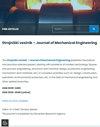金属丝产生激光液滴的非线性动态力平衡质量-弹簧-阻尼器模型
IF 1.2
4区 工程技术
Q3 ENGINEERING, MECHANICAL
Strojniski Vestnik-Journal of Mechanical Engineering
Pub Date : 2018-04-24
DOI:10.5545/SV-JME.2019.6062
引用次数: 0
摘要
直接激光金属沉积是现有的金属基增材制造工艺之一[1]。通常采用线材[2]或粉末[3]形状的输入材料。与使用激光在工件表面产生熔池的线材或粉末沉积工艺相比,金属液滴沉积工艺大大降低了工件热负荷,因为激光束仅用于液滴的产生。因此,金属液滴已被用于各种创新技术,包括电触点的液滴连接、异种材料和温度敏感材料的液滴连接[4],以及3D打印[5]。液滴技术的必要基础是可靠的金属液滴生成方法。为了实现这一目标,已经开发了许多基于喷嘴熔体喷射的金属液滴生成方法,采用不同的技术来产生喷射脉冲:压电[6],气动[7],电磁[8]和电磁[9]。上述方法采用加热坩埚来维持熔融金属的储罐。使用熔点相对较低的金属,如焊料[9]、铟、铅、锌[7]和铝[10]。为了避免坩埚的节能和简化系统,提出了一种导线尖端在通往喷嘴的加压管中感应熔化的方法[11]。上述所有方法的共同之处在于喷嘴,其直径应远低于所产生液滴的直径,并且容易磨损。为避免熔体氧化导致喷嘴堵塞,应提供低氧含量的气氛[7]。除了基于熔体喷射的方法外,还开发了几种基于激光的方法,这些方法利用了激光能量传递的高水平时空控制。它们在输入金属材料的形状方面有所不同,输入金属材料可以是箔[12],球形预成型[13]或导线[14]。尽管与熔体喷射法相比,环形激光束在金属丝上产生激光液滴的频率较低[15],但由于它可以使用镍等高熔点金属[14],对氧含量不太敏感,且相关系统不含可磨损部件,因此具有很强的应用潜力。在环形激光束液滴产生(ALDG)中,金属丝轴向送入环形激光束的中心,金属丝聚焦在金属丝末端的圆周上。金属丝激光液滴生成的非线性动态力平衡质量-弹簧-阻尼器模型[14],a . - Govekar, E. Andrej Jeromen*本文章由计算机程序翻译,如有差异,请以英文原文为准。
Nonlinear Dynamic Force Balance Mass-spring-damper Modelof Laser Droplet Generation from a Metal Wire
Direct laser metal deposition is one of the established metal-based additive manufacturing processes [1]. It usually employs input material in shape of wire [2] or powder [3]. In contrast to the wire or powder deposition process, where the laser is used to generate melt pool on the workpiece surface, the process of metal droplet deposition significantly reduces the workpiece heat load, since the laser beam is used only for droplet generation. In consequence, metal droplets have been employed in various innovative technologies, including the droplet joining of electrical contacts, and of dissimilar and temperaturesensitive materials [4], as well as 3D printing [5]. A necessary basis for droplet-based technologies is a reliable method for the generation of metal droplets. To achieve this, a number of metal-droplet generation methods based on melt ejection from a nozzle have been developed, employing different techniques to generate the ejection pulse: piezoelectric [6], pneumatic [7], solenoid [8], and electromagnetic [9]. The above methods employ a heated crucible to maintain a reservoir of molten metal. Metals with relatively low melting temperatures are used, such as solder [9], indium, lead, zinc [7], and aluminum [10]. To avoid an energy-inefficient crucible and simplify the system, a method employing induction melting of the wire tip in the pressurized tube leading to the nozzle was proposed [11]. Common to all of the above methods is the nozzle, the diameter of which should be well below the diameter of the generated droplets and is subject to wear. To avoid melt oxidation, leading to nozzle clogging, a low-oxygen-content atmosphere should be provided [7]. Besides the methods based on melt ejection, several laser-based methods have been developed that take advantage of the high level of spatial and temporal control of the laser’s energy delivery. They differ in terms of the shape of the input metal material, which can be either a foil [12], a spherical preform [13], or a wire [14]. Although it achieves lower dropletgeneration frequencies compared to melt-ejection methods, the laser droplet generation from a wire using an annular laser beam [15] shows strong application potential, since it can employ metals with a high melting point, such as nickel [14], is not very sensitive to oxygen content, and the related system includes no wearable parts. In annular laser beam droplet generation (ALDG), a metal wire is fed axially into the center of the annular laser beam, which is focused on the circumference of the wire-end. ALDG can be performed either as drop-on-demand ALDG [14], where the pendant-droplet formation and detachment Nonlinear Dynamic Force Balance Mass-spring-damper Model of Laser Droplet Generation from a Metal Wire Jeromen, A. – Govekar, E. Andrej Jeromen* – Edvard Govekar University of Ljubljana, Faculty of Mechanical Engineering, Slovenia
求助全文
通过发布文献求助,成功后即可免费获取论文全文。
去求助
来源期刊
CiteScore
3.00
自引率
17.60%
发文量
56
审稿时长
4.1 months
期刊介绍:
The international journal publishes original and (mini)review articles covering the concepts of materials science, mechanics, kinematics, thermodynamics, energy and environment, mechatronics and robotics, fluid mechanics, tribology, cybernetics, industrial engineering and structural analysis.
The journal follows new trends and progress proven practice in the mechanical engineering and also in the closely related sciences as are electrical, civil and process engineering, medicine, microbiology, ecology, agriculture, transport systems, aviation, and others, thus creating a unique forum for interdisciplinary or multidisciplinary dialogue.

 求助内容:
求助内容: 应助结果提醒方式:
应助结果提醒方式:


